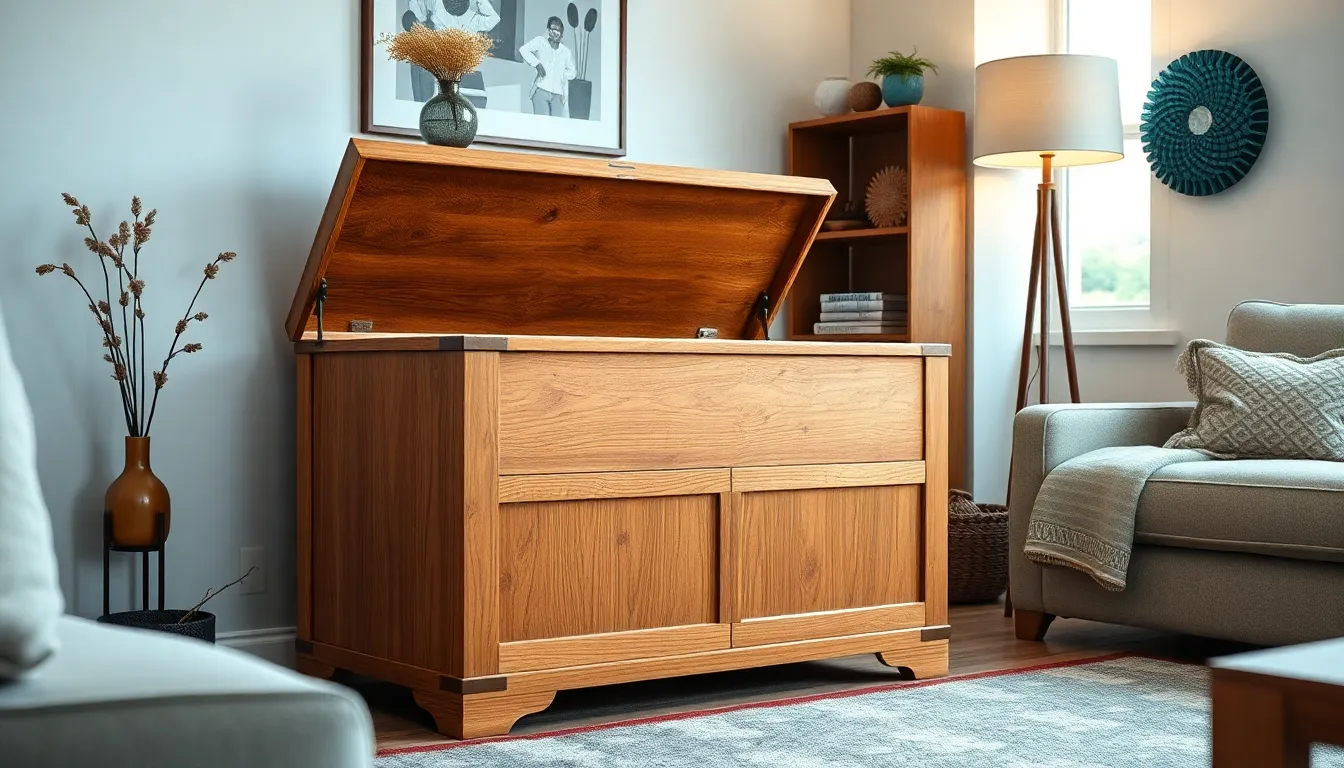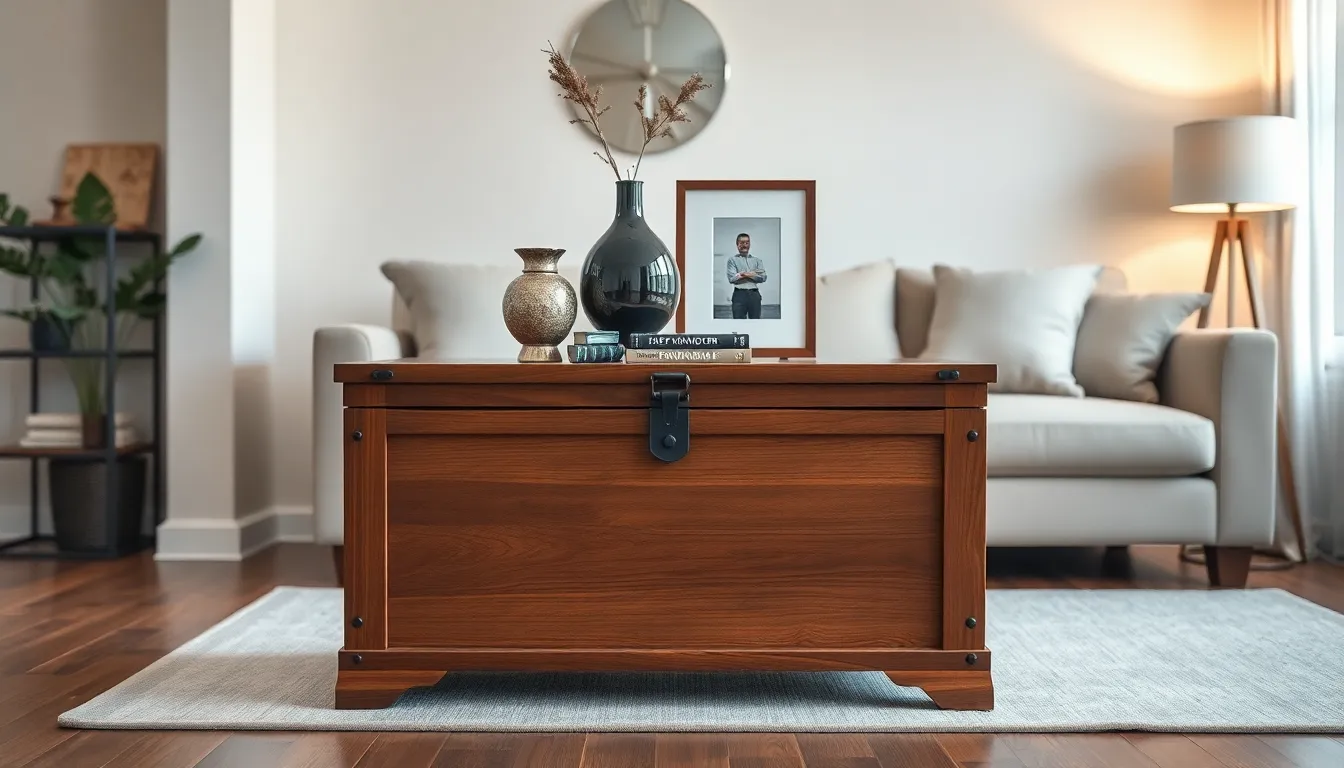Table of Contents
ToggleImagine a piece of furniture that’s not just a pretty face but also a secret superhero of your home. Enter the furniture chest—your new best friend in the battle against clutter. This versatile gem combines style and function, offering a stylish solution for hiding everything from blankets to board games. Who knew storage could look this good?
Overview of Furniture Chests
Furniture chests serve as stylish and functional storage solutions for various items in a home. These versatile pieces enhance organization while maintaining aesthetic appeal.
Definition and Purpose
A furniture chest refers to a box-like storage unit designed for keeping items neatly stored away. Its purpose extends beyond organization, as it also functions as a supplementary surface for displaying decorative pieces or providing extra seating. Commonly used in living rooms, bedrooms, and entryways, it effectively conceals items like blankets, toys, or out-of-season clothing. Often crafted from wood or upholstered materials, a well-chosen chest can complement existing decor while reducing clutter.
Types of Furniture Chests
Various types of furniture chests exist to cater to different needs and styles. Cedar chests, for instance, offer both storage and natural moth-repelling properties, ideal for clothing and linens. Ottomans combine seating with storage, making them suitable for living spaces. Trunks evoke a vintage charm, often repurposed for stylish organization. Though differing in design and functionality, all types enhance interior spaces by providing efficient storage solutions while adding character to a room.
Materials Used in Furniture Chests

Furniture chests incorporate various materials that enhance durability and style. Understanding these materials helps with selecting the right piece for any home.
Wood Options
Wood options provide warmth and elegance to furniture chests. Oak offers strong, durable qualities, making it ideal for long-lasting pieces. Pine is lightweight and cost-effective, which fits budget-friendly needs. Walnut displays rich grains and deep hues, catering to a more luxurious aesthetic. Cherry wood ages beautifully, developing a unique patina over time. Each type serves a distinct purpose while complementing different interior styles.
Metal and Other Materials
Metal and other materials contribute modern flair to furniture chests. Aluminum brings lightweight strength, creating easy-to-move chests perfect for various settings. Steel provides robust support, ensuring durability for heavy storage. Rattan and wicker add texture, infusing a casual, coastal vibe. Upholstered options feature soft fabrics like velvet or linen, enhancing comfort for dual-use chests. These diverse materials allow for unique stylistic expressions and practical solutions tailored to personal taste.
Choosing the Right Furniture Chest
Selecting the ideal furniture chest involves balancing size and style with functionality.
Size Considerations
Determining the appropriate size is crucial for effective usage. Measure the intended space before choosing a chest. A piece that’s too large can overwhelm a room, while one that’s too small may fail to serve its purpose. Consider height, width, and depth for optimal placement. For example, a chest under 40 inches works well in tight areas, such as entryways. Conversely, larger chests, around 50 inches or more, suit living rooms or bedrooms where ample storage is needed. Ensure that the chest complements existing furniture without crowding the space.
Style and Design
Style significantly influences the overall aesthetic of a room. Various design options allow for personal expression. Traditional wooden chests exude warmth, while metal finishes lend a modern touch. Colors also play a vital role; neutral tones integrate seamlessly into various decors, while bold hues can serve as focal points. For instance, a rustic cedar chest enhances farmhouse styles, while a sleek upholstered ottoman fits contemporary settings. Selecting a design that harmonizes with surrounding elements ensures the piece enhances the room’s appeal rather than detracts from it.
Maintenance and Care
Maintaining a furniture chest ensures its longevity and sustained aesthetic appeal. Regular attention to care keeps it looking great while serving its functional purpose.
Cleaning Tips
Cleaning requires a gentle approach. Dust regularly using a soft cloth to prevent the buildup of dirt on surfaces. Use a damp cloth for deeper cleaning, avoiding harsh chemicals that might damage the finish. Leather and fabric chests benefit from vacuuming with an upholstery attachment for dirt removal. An occasional polish enhances shine, particularly on wooden chests, while following manufacturer instructions ensures safety.
Preventing Damage
Preventing damage involves strategic placement and use of the furniture chest. Positioning away from direct sunlight helps avert color fading. Placing coasters under decorative items minimizes scratches. Keeping heavy items away from edges reduces risk of tilting or tipping. Using felt pads on the bottom of items provides a protective barrier against scuffs. Keeping the storage area dry prevents mold and mildew.
A furniture chest stands out as a versatile addition to any home. Its blend of style and practicality makes it an ideal solution for managing clutter while enhancing living spaces. With various materials and designs available, homeowners can find the perfect chest to complement their decor and meet their storage needs.
Proper care and maintenance ensure these pieces remain beautiful and functional for years to come. By choosing the right furniture chest, individuals can effectively combine aesthetics with organization, transforming their homes into stylish and orderly retreats.








